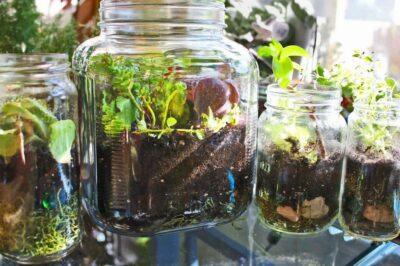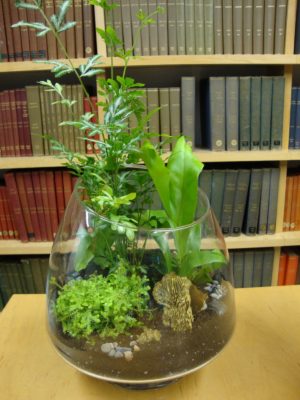
Image source: redtedart.com
Were you one of those people who loved looking at ships in bottles? Did you ever wonder how the ships got in there? Now, imagine having a miniature garden in a bottle, or more likely an aquarium. You can still be fascinated by the miniature fruits, vegetables and herbs, while creating an edible, yet eye-catching masterpiece.
What am I talking about? Terrarium gardening, where plants are grown in an enclosed (fully or partially) clear container. It is used to help plants grow which need higher-than-usual humidity. You can build a terrarium using bottles, fish bowls or aquariums, and even jars. Once the plants are established in the terrarium, they create their very own climate. The moisture from the plants condense on the glass, accumulates and then goes back into the soil. This helps to reduce the amount of watering needed.
Where to Start
A terrarium is made of four layers. The bottom layer is comprised of pebbles or very coarse sand for drainage. The next layer should be thin and consist of activated charcoal (like an aquarium filter). This layer will filter fumes from decomposing material. Sphagnum moss should be used in the following layer. It will stop the soil from sifting through to the bottom layer. The very top layer is where you add your soil. Do not use fertilizers and do not use beach sand. You can get specific soil mix for terrariums at the gardening store, or you can mix part builders sand (coarse) with the same amount of leaf mold (humus) to two parts of the standard mix. Lids are not necessary unless your plants need a tropical environment.
Without A Doubt The Best Kept Secret In Indoor Self-Reliance Gardening…
Terrariums are a visual treat, and everything is miniaturized. It is a good idea to start planning with a drawing of where plants will go. Use something special as a focal point, and then decide on the location of plants, with tall ones at the back. By placing tall plants at the back and gradually getting smaller, you will be able to see all plants when looking in the terrarium.
Now the Plants
Large terrariums are better for fruit that grow vertically, like dwarf trees. Keep in mind: It is not a good idea to grow your plants in full sun, because it gets too hot and humid. Here is a small selection of fruits, vegetables and herbs known to do well in a terrarium.
1. Creeping figs – Smaller versions of this plant do well in terrariums. They prefer indirect sunlight, and can handle some shade. Creeping figs are easily pruned if they grow too large. The plants will make your terrarium look like a miniature forest.

Image source: homegardenair.com
2. Thyme – Thyme is an herb that doesn’t like soggy roots. Place thyme in a drier area of the terrarium, like on a mound. It likes at least six hours of sunlight, but indirect light is fine. Allow the soil around this plant to dry fully before watering again.
3. Varieties of tomatoes – Small types of tomatoes, like Tiny Tim, do very well in a terrarium. They only grow to be one foot high, and produce tomatoes the size of grapes. These types of tomatoes don’t need as much light as other tomatoes, making them easy to care for.
4. Dwarf pineapple – This is a sun-loving plant, just like the full-sized pineapple. Dwarf pineapples can grow from 18 to 20 inches tall. Believe it or not, they actually grow miniature fruit. Its leaves will spread over time, so may need pruning.
The Best Source For Tomato Heirloom Seeds Is Right Here!
5. Mint – Mint is an easy herb to grow indoors and does well in a terrarium. Mint needs indirect sunlight. It likes to have moist but not soggy soil. Its care is similar to the care needed for thyme. If needed, mist between waterings.
6. Dwarf tophat blueberries – This plant needs an open terrarium, meaning no lid. It takes a few years to fully mature, but produces edible blueberries. It does like full sun for best results. Tophat blueberries have blossoms that self-pollinate, making the growing process that much easier. Keep in mind this plant can grow as large as two feet wide and tall.
7. Oregano – Oregano grows well with thyme and sage. It likes well-drained soil that dries out between waterings. This herb likes to have between six and eight hours of sunlight and does well with frequent trims and pruning.
8. Sage – This aromatic, tasty herb grows well in a terrarium because it likes a bit of humidity. Sage also likes plenty of sunlight, around six to eight hours. Like many herbs, sage needs soil that drains well. You should only water this herb when needed, when the top inch of soil is dry.
Terrariums are micro ecosystems. You will need to have plants that can exist together. Remember to read packets or tags so you buy plants that don’t have conflicting needs, or prefer different amounts of light.
Enjoy your terrarium at home — or give it as a gift.
Have you ever grown an indoor terrarium garden? Share your tips in the section below:
Growing A Terrarium? Do You Know The Biggest Mistake Gardeners Will Make This Year? Read More Here.
 Off The Grid News Better Ideas For Off The Grid Living
Off The Grid News Better Ideas For Off The Grid Living



